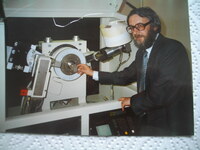
| Home > LEO Computers > LEOPEDIA > Other Memoirs, Reminiscences > Brian Beagley: Life Profile |
Brian Beagley: Life Profile
|
Brian Beagley, doing a vacation job as a Schoolboy in the mid 1950’s, was offered an engineering job, mentored by John Pinkerton at the LEO manufacturing sites and contributed to the work being carried out. He carries a lifetime memory of those days. From Brian: Born in December in 1936 in Kensington, West London. Grew up during WW2 in Fulham. Attended St John’s School, Dawes Road and the Sunday School at the Congregational Church next door. The Church was blitzed by Nazi bombing. Thereafter attended Hammersmith Broadway Congregational Church. Completed primary education at St John’s, age 11. In 1948, won a Governor’s Scholarship to Latymer Upper School in Hammersmith, eventually specialising in science. In 1954/55 Brian spent his school vacations working for LEO Computers Ltd. Won a State Scholarship in 1955/56.in Chemistry, Physics and both Pure and Applied Mathematics. Accepted as a student in the Department of Chemistry at the University of Birmingham. Graduated with a BSc in 1959. Married Janet May Dowling on 19th September 1959 in Hammersmith Broadway Congregational Church. Completed PhD studies on Determination of Crystal Structures by Xray Diffraction Methods (XRD). On receiving his PhD in 1962, he was made a DSIR/NATO Fellow 1962-1964. He was headhunted in 1963 by Professor Durward Cruickshank who was interested, not only in his PhD research, but also in Brian’s pre-University experience, gained working on the building of the LEO II computer. Brian (as a NATO Fellow) and Janet moved to Oslo, Norway, in autumn 1963. Brian joined Professor Otto Bastiansen’s Gas Phase Electron Diffraction (GED) Group at the University of Oslo. Returning to the UK in 1964, they moved to Kirkintilloch near Glasgow where Brian joined the academic staff in the Chemistry Department of the University, working for Professor Cruickshank. Brian and Janet had two children together, Sarah Helen Beagley, 30th August 1964 in London, and Philip Edwin Dowling Beagley, 12th July 1967 in Glasgow. Cruickshank moved to UMIST in 1967. Brian and Janet followed him to Manchester in 1967 and settled in Romiley, Stockport. Brian continued his work with Cruickshank in the Chemistry Department at UMIST and in canal restoration (see below). Janet took up employment in Child Care in Stockport. At UMIST, Brian progressed from Lecturer, then Senior Lecturer then to Reader, retiring in 1996. Community Service 1967-1974: Brian and Janet returned from Norway and Glasgow to Manchester, Brian was appointed Chairman of the Peak Forest Canal Society in 1970. He led the campaign tor the reopening of the Cheshire Canal Ring, which involved spearheading the argument to persuade the authorities to restore the Peak Forest and Ashton Canals. These canals were restored and reopened in 1974. During this period, public awareness of the importance of canals as a valuable heritage was realised and much modern town-planning thereafter (e.g. in Birmingham) took account of canals as an open space (“lung”) within the metropolis of a town centre (e.g. London, Manchester). Author profile during Brian’s scientific career Photo taken in the 1990s in a laboratory in Manchester University. Date : April 2022This exhibit has a reference ID of CH68700. Please quote this reference ID in any communication with the Centre for Computing History. |
Click on the Images For Detail
|










